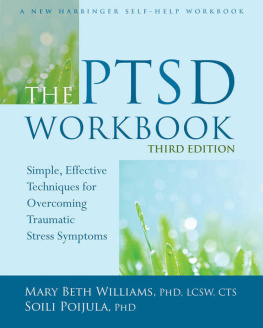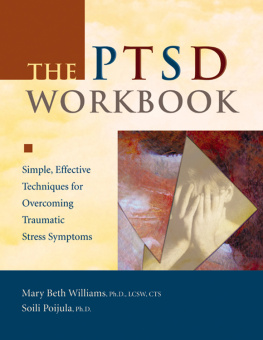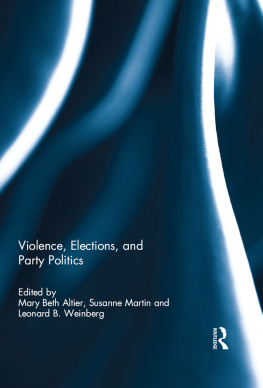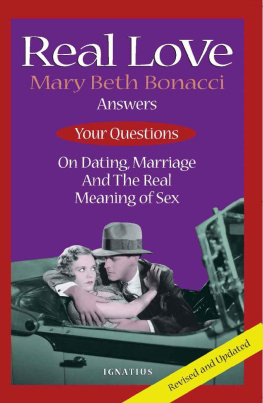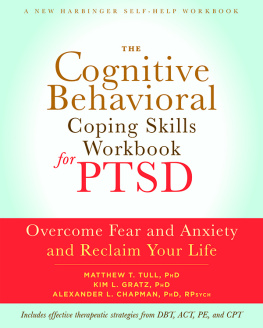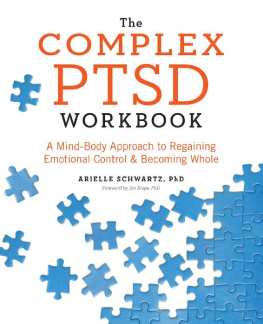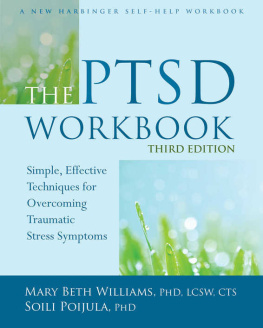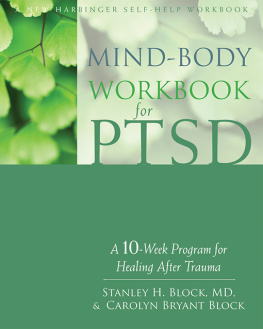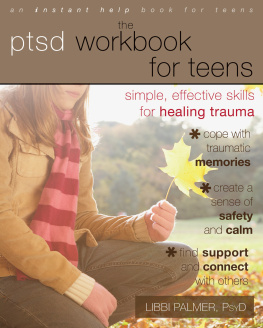Mary Beth Williams - The PTSD Workbook
Here you can read online Mary Beth Williams - The PTSD Workbook full text of the book (entire story) in english for free. Download pdf and epub, get meaning, cover and reviews about this ebook. City: Oakland, CA, year: 2016, publisher: New Harbinger, genre: Religion. Description of the work, (preface) as well as reviews are available. Best literature library LitArk.com created for fans of good reading and offers a wide selection of genres:
Romance novel
Science fiction
Adventure
Detective
Science
History
Home and family
Prose
Art
Politics
Computer
Non-fiction
Religion
Business
Children
Humor
Choose a favorite category and find really read worthwhile books. Enjoy immersion in the world of imagination, feel the emotions of the characters or learn something new for yourself, make an fascinating discovery.
- Book:The PTSD Workbook
- Author:
- Publisher:New Harbinger
- Genre:
- Year:2016
- City:Oakland, CA
- Rating:4 / 5
- Favourites:Add to favourites
- Your mark:
- 80
- 1
- 2
- 3
- 4
- 5
The PTSD Workbook: summary, description and annotation
We offer to read an annotation, description, summary or preface (depends on what the author of the book "The PTSD Workbook" wrote himself). If you haven't found the necessary information about the book — write in the comments, we will try to find it.
The PTSD Workbook — read online for free the complete book (whole text) full work
Below is the text of the book, divided by pages. System saving the place of the last page read, allows you to conveniently read the book "The PTSD Workbook" online for free, without having to search again every time where you left off. Put a bookmark, and you can go to the page where you finished reading at any time.
Font size:
Interval:
Bookmark:
The PTSD Workbook is an outstanding aid to those recovering from exposure to traumatic life events and the symptoms of post-traumatic stress disorder (PTSD). For use while in psychotherapy or by itself, this workbook provides an important guideline and template for moving forward with life. Derived from considerable clinical experience and up-to-date with recent research on recovery, The PTSD Workbook is an invaluable addition to the growing number of clinical tools to improve resiliency and enhance healthy outcomes.
Terence M. Keane, PhD, associate chief of staff for research and development at the VA Boston Healthcare System, director of the behavioral science division of the National Center for PTSD, and professor of psychiatry and assistant dean of research at the Boston University School of Medicine
This is a treasure trove of a book filled with up-to-date information on trauma, with the best collection of self-help methods in the field. It is easy to understand, and will be a resource for all individuals who are suffering from the effects of traumatic events, as well as for professionals.
Atle Dyregrov, PhD, clinical and research psychologist, and head of professional issues at the Center for Crisis Psychology in Bergen, Norway; professor of clinical psychology at the University of Bergen, Norway; author of Disaster Psychology, Children in War, Grief in Children, and Supporting Traumatized Children and Teenagers; founding member of the European Society for Traumatic Stress Studies; and chair of the Children and War Foundation
This update of The PTSD Workbook nicely reflects the authors sensitive understanding of psychological trauma and resilience. It provides individuals suffering from post-traumatic stress disorder (PTSD) and their professional helpers with an impressive compendium of self-help and therapeutic techniques. Each of its twelve chapters is full of easy-to-use exercises that allow readers to decide which techniques are most suited to their individual situation. Anyone with a personal experience of, or exposure to, traumatic events will learn something useful from an encounter with this excellent work.
Joseph H. Albeck, MD, clinical associate in the department of psychiatry at McLean Hospital in Belmont, MA; Chairman (Emeritus) for the Intergenerational Transmission of Trauma and Resilience Special Interest Group of the International Society for Traumatic Stress Studies (ISTSS); and cofounder of the New England Holocaust Memorial
This is an extremely helpful book for trauma victims and facilitators, but also for you and me, to own and look into it daily.
Hdi Fried, psychologist, writer, teacher, Holocaust survivor, author of The Road to Auschwitz, and winner of the 2015 Public Advocacy Award from the International Society for Traumatic Stress Studies (ISTSS)

Publishers Note
This publication is designed to provide accurate and authoritative information in regard to the subject matter covered. It is sold with the understanding that the publisher is not engaged in rendering psychological, financial, legal, or other professional services. If expert assistance or counseling is needed, the services of a competent professional should be sought.
Distributed in Canada by Raincoast Books.
Elements from The Body Remembers: The Psychophysiology of Trauma and Trauma Treatment by Babette Rothschild. Copyright 2000 by Babette Rothschild. Used by permission of W. W. Norton & Company, Inc.
Assessing Your Self-Criticism, Using Self-Compassion Phrases, and Fostering Self-Compassion adapted from SELF-COMPASSION: STOP BEATING YOURSELF UP AND LEAVE INSECURITY BEHIND by Kristin Neff, copyright 2011, published by HarperCollins Publishers. Used by permission of author.
Copyright 2016 by Mary Beth Williams and Soili Poijula
New Harbinger Publications, Inc.
5674 Shattuck Avenue
Oakland, CA 94609
www.newharbinger.com
Cover design by Amy Shoup; Edited by Brady Kahn; Acquired by Catharine Meyers; Text design by Tracy Marie Carlson
All Rights Reserved
Library of Congress Cataloging-in-Publication Data on file
One never knows the curves that life brings. In the second edition, I dedicated this book to my children, never imagining that January 2014 would bring the unexpected death of my son Cary. This revised edition is dedicated to him and his strong will to live.
MBW
I would like to dedicate this book to my mother, Maria, a war orphan herself, and the mother of mothers.
SP
This book is also dedicated to survivors throughout the world. It is also dedicated to all the helping professionals, members of the military, law enforcement officers, and fire, rescue, and EMT personnel who serve in spite of the challenges, danger of compassion fatigue, and certainty of impact of the work on their own lives, including potential loss of life.
MBW and SP
Mary Beth Williams
A s the third edition of this workbook goes to print, subsequent anniversaries of 9/11 have come and gone. New terrorist groups, even more brutal, have come to the forefront. Security checks and rechecks continue to be a way of life: take off your shoes and put them in the container, take all metal out of your pockets, and hold up your arms over your head for the X-ray version of a strip search.
In spite of preventive efforts and best practices such as Resilience Training or Comprehensive Soldier Fitness education for those going into combat, and in spite of increased emphasis on resilience and post-traumatic growth, thousands upon thousands of young men and women have been wounded in many ways through repeated deployments, exposure to guerilla-type warfare, blasts from improvised explosive devices (IEDs) that have led to amputations and traumatic brain injuries, and other war-related traumatic events.
The US Department of Veterans Affairs (also known as the Veterans Administration, or VA) is overwhelmed with claims from veterans of past wars, particularly Vietnam veterans reaching retirement age. Now that their productive work lives are winding down, these veterans are finding that their previously effective avoidance mechanisms are no longer keeping away the memories of the past. They also are coming face-to-face with mortality as the effects of Agent Orange, dormant for decades, invade their bodies in the form of type 2 diabetes, prostate cancer, and many other VA-accepted illnesses and diseases. Add to these veterans others from Desert Storm, OEF, OIF, and other military operations, and the wait time to process an initial claim may run eighteen months or so; if veterans dispute the rating they receive, it may take another eighteen months to two years to get reconsideration.
In the years since the first edition of this book was published in 2002, tragedies and disasters have continued to plague the world. The Virginia Tech shooting in 2007 was the deadliest massacre by a single perpetrator in US history. The Aurora, Colorado, shooting on July 20, 2012, had seventy American victims, twelve of whom died. The Newtown, Connecticut, shooting on December 14, 2012, left twenty children and six adult staff members of the elementary school dead, as well as the shooters mother and the shooter himself, who died from a self-inflicted injury. The terrorist bombing at the end of the Boston Marathon a few months later reminded Americans again that we are not totally safe in any setting.
Tragic school shootings with many victims have twice occurred in Finland and in Germany as well. Tuija Turunens excellent doctoral dissertation (2014) focusing on the Jokela school shootings described how that communitys outpouring of support for relatives and coworkers of victims could serve as a model of ongoing psychosocial support. This model ought to be adopted by American response teams and crisis intervention professionals.
Next pageFont size:
Interval:
Bookmark:
Similar books «The PTSD Workbook»
Look at similar books to The PTSD Workbook. We have selected literature similar in name and meaning in the hope of providing readers with more options to find new, interesting, not yet read works.
Discussion, reviews of the book The PTSD Workbook and just readers' own opinions. Leave your comments, write what you think about the work, its meaning or the main characters. Specify what exactly you liked and what you didn't like, and why you think so.

